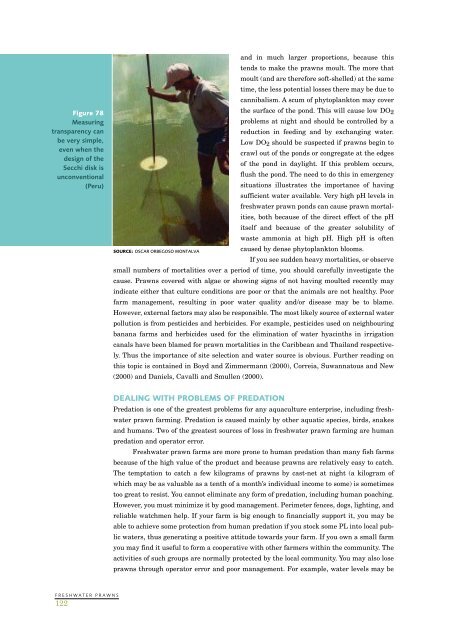You also want an ePaper? Increase the reach of your titles
YUMPU automatically turns print PDFs into web optimized ePapers that Google loves.
Figure 78Measuringtransparency canbe very simple,even when thedesign of theSecchi disk isunconventional(Peru)and in much larger proportions, because thistends to make the <strong>prawns</strong> moult. The more thatmoult (and are therefore soft-shelled) at the sametime, the less potential losses there may be due tocannibalism. A scum of phytoplankton may coverthe surface of the pond. This will cause low DO 2problems at night and should be controlled by areduction in feeding and by exchanging water.Low DO 2 should be suspected if <strong>prawns</strong> begin tocrawl out of the ponds or congregate at the edgesof the pond in daylight. If this problem occurs,flush the pond. The need to do this in emergencysituations illustrates the importance of havingsufficient water available. Very high pH levels in<strong>freshwater</strong> prawn ponds can cause prawn mortalities,both because of the direct effect of the pHitself and because of the greater solubility ofwaste ammonia at high pH. High pH is oftenSOURCE: OSCAR ORBEGOSO MONTALVAcaused by dense phytoplankton blooms.If you see sudden heavy mortalities, or observesmall numbers of mortalities over a period of time, you should carefully investigate thecause. Prawns covered with algae or showing signs of not having moulted recently mayindicate either that culture conditions are poor or that the animals are not healthy. Poorfarm management, resulting in poor water quality and/or disease may be to blame.However, external factors may also be responsible. The most likely source of external waterpollution is from pesticides and herbicides. For example, pesticides used on neighbouringbanana farms and herbicides used for the elimination of water hyacinths in irrigationcanals have been blamed for prawn mortalities in the Caribbean and Thailand respectively.Thus the importance of site selection and water source is obvious. Further reading onthis topic is contained in Boyd and Zimmermann (2000), Correia, Suwannatous and New(2000) and Daniels, Cavalli and Smullen (2000).DEALING WITH PROBLEMS OF PREDATIONPredation is one of the greatest problems for any aquaculture enterprise, including <strong>freshwater</strong>prawn farming. Predation is caused mainly by other aquatic species, birds, snakesand humans. Two of the greatest sources of loss in <strong>freshwater</strong> prawn farming are humanpredation and operator error.Freshwater prawn farms are more prone to human predation than many fish farmsbecause of the high value of the product and because <strong>prawns</strong> are relatively easy to catch.The temptation to catch a few kilograms of <strong>prawns</strong> by cast-net at night (a kilogram ofwhich may be as valuable as a tenth of a month’s individual income to some) is sometimestoo great to resist. You cannot eliminate any form of predation, including human poaching.However, you must minimize it by good management. Perimeter fences, dogs, lighting, andreliable watchmen help. If your farm is big enough to financially support it, you may beable to achieve some protection from human predation if you stock some PL into local publicwaters, thus generating a positive attitude towards your farm. If you own a small farmyou may find it useful to form a cooperative with other farmers within the community. Theactivities of such groups are normally protected by the local community. You may also lose<strong>prawns</strong> through operator error and poor management. For example, water levels may beFRESHWATER PRAWNS122
















